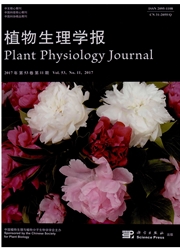

 中文摘要:
中文摘要:
油菜素甾醇(brassinosteroids,BRs)是植物中的一类类固醇激素,可调控许多至关重要的生长发育过程。BR特异的生物合成由CR(campesterol)起始,经由多条途径,受DWF4、CPD、DET2、ROT3/CYP90D1、Ps DDWF1、BR6ox1/2等生物合成酶的催化最终形成生物活性最高的BR,即油菜素内酯(brassinolide,BL)。其中不依赖于CN(campestanol)的一条八步合成途径,在拟南芥中被证明是最主要的生物合成途径。BR代谢产物众多,但目前已发现相关酶的代谢方式仅包括羟基化、糖基化、磺酰化、还原反应和酰基化。BR信号由细胞质膜上的受体BRI1和共受体BAK1的胞外结构域共同感知,进而引起抑制因子BKI1从BRI1上解离,并使BRI1和BAK1的激酶结构域相互作用并相互磷酸化激活,激活的BRI1可磷酸化激活BSKs和CDGs,BSKs和CDGs再激活下游磷酸酶BSU1,BSU1可去磷酸化失活负调元件BIN2,从而解除BIN2对下游转录因子BZR1和BES1的磷酸化抑制,非磷酸化的BZR1和BES1进入细胞核正调或负调多种靶基因。
 英文摘要:
英文摘要:
Brassinosteroids (BRs) are a class of steroidal phytohormones playing essential roles during normal plant growth and development. In Arabidopsis, an 8-step campestanol (CN)-independent pathway, starting from campesterol (CR) to the final and most active BR, brassinolide (BL), has been demonstrated as the predominant BR biosynthetic pathway. Reactions in this pathway are catalyzed by a series of enzymes including DWF4, CPD, DET2, ROT3/CYP90D1, PsDDWF 1, and BR6ox1/2. Although dozens of BR catabolites have been iden- tified, only a few enzymes corresponding to their formation have been discovered. These enzymes catalyze sev- eral catabolic reactions including hydroxylation, glycosylation, sulfonylation, reduction, and acylation. BRs are mainly perceived by their receptor BRI1 and co-receptor BAK1. Direct interaction between BRs and the extra- cellular domains of BRI1 and BAK1 triggers dissociation of a cytoplasmic inhibitory component BKI1 and as- sociation of BRI1 kinase domain with BAK1 kinase domain. The activated BRI1-BAK1 complex can then phosphorylate downstream receptor-like cytoplasmic kinases, BSKs and CDGs. The activated BSKs and CDGs can inhibit kinase activity of a negative regulator BIN2 via a protein phosphatase, BSU1. Dephosphoylation of BIN2 can result in the accumulation of two unphosphorylated transcription factors BZR1 and BES1 in the nu- clei, which can directly mediate the expression of numerous BR responsive genes.
 同期刊论文项目
同期刊论文项目
 同项目期刊论文
同项目期刊论文
 期刊信息
期刊信息
